Trees, Shrubs and Woody Vines
Media
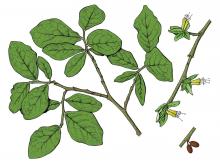
Species Types
Scientific Name
Dirca palustris
Description
Eastern leatherwood is a native shrub of bottomlands, stream banks, and bases of bluffs. It has unusual little dangling yellow flowers, and its twigs are surprisingly flexible.
Media

Species Types
Scientific Name
Viburnum rufidulum
Description
Southern black haw is an irregularly branched shrub with shiny, dark green, opposite leaves whose lower surface is paler with scattered rusty hairs, especially on the veins. It bears clusters of white flowers, which turn into bluish-black fruits.
Media
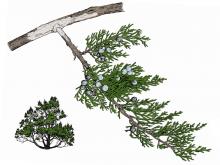
Species Types
Scientific Name
Juniperus ashei
Description
In Missouri, Ashe’s juniper is uncommon and only found in a few southwestern counties; our populations represent the northeastern tip of its range. Here, it is much less widespread than its close relative eastern red cedar.
Media

Species Types
Scientific Name
Callicarpa americana
Description
American beautyberry is a many-branched shrub that bears attractive rounded clusters of purple berrylike fruits in the axils of the leaves in late summer and fall. A critically imperiled species in Missouri, it is also a popular native shrub for landscaping.
Media
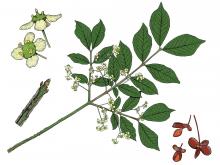
Species Types
Scientific Name
Euonymus alatus
Description
Burning bush, or winged euonymus, is a nonnative shrub that has been very popular in landscaping for its bright red fall foliage. But it is invasive and spreads aggressively into natural habitats, displacing native species.
Media
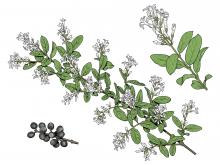
Species Types
Scientific Name
Ligustrum spp.
Description
Four species of privets occur in Missouri, all are nonnative, and all are considered invasive or potentially invasive. When they invade natural habitats, they can form dense thickets that crowd out native vegetation.
Media

Species Types
Scientific Name
Forestiera acuminata
Description
Swamp privet is a straggly shrub or small tree growing in wet to swampy ground. It is quite noticeable in early spring, with the clusters of yellow flowers and bracts appearing along the gray branches before the leaves come out. In this way, it is similar in aspect to spicebush.
Media
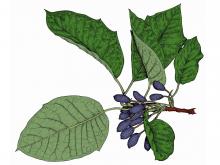
Species Types
Scientific Name
Nyssa aquatica
Description
Water tupelo, or tupelo gum, is a large tree with a large, swollen, sometimes buttressed base, a tapering trunk, and a flattened, spreading crown. It and bald cypress are the dominant trees in Missouri’s Bootheel swamps.
Media

Species Types
Scientific Name
Rhamnus caroliniana (syn. Frangula caroliniana)
Description
Carolina buckthorn occurs in the southeastern half of Missouri. It’s a shrub with several main stems, or a small tree potentially reaching 40 feet high, with a trunk diameter of up to 8 inches. Despite the name, there are no thorns.
Media

Species Types
Scientific Name
Rubus occidentalis
Description
Black raspberries resemble blackberries, but when ripe, the fruits fall away as a caplike unit from the receptacle. Leaflets appear white underneath. The canes are whitish-coated when young; they arch down and take root at the tips. Native and scattered statewide.
See Also
About Trees, Shrubs and Woody Vines in Missouri
There are no sharp dividing lines between trees, shrubs, and woody vines, or even between woody and nonwoody plants. “Wood” is a type of tissue made of cellulose and lignin that many plants develop as they mature — whether they are “woody” or not. Trees are woody plants over 13 feet tall with a single trunk. Shrubs are less than 13 feet tall, with multiple stems. Vines require support or else sprawl over the ground.





















